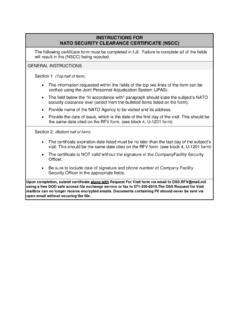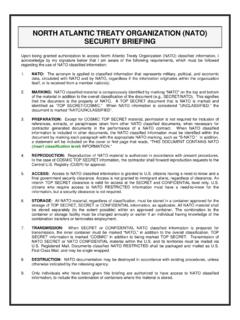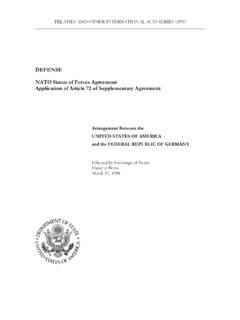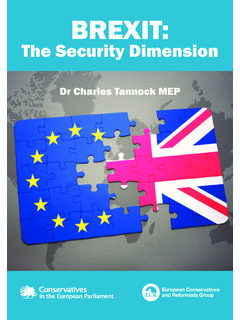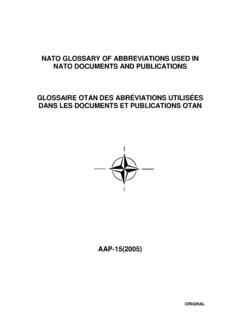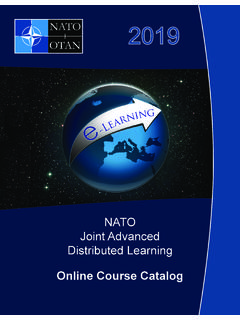Transcription of DMS GENSER Message Security Classifications, Categories ...
1 Attachment 5 (3-8460-042399) DMS GENSER Message Security Classifications, Categories , and Marking Phrase Requirements Version 19 March 1999 Prepared by: DEFENSE INFORMATION SYSTEMS AGENCY This Page Intentionally BlankDMS GENSER Message Classifications, Categories , and Markings ( ) -1- 1. INTRODUCTION PURPOSE This document prescribes the requirements for Defense Message System (DMS) General Service ( GENSER ) Message classifications, Categories and markings. These requirements are to be incorporated into mechanisms performing formal access control and in applying classification , category, and dissemination control marking phrases to messages, as appropriate. The proper implementation of these requirements is intended to provide interoperability with respect to Security classifications and Categories of DMS GENSER messaging, GENSER messaging current practices, and with the Automatic Digital Network (AUTODIN) system and its users.
2 Included are requirements for interoperability with Allied and nato originators and recipients. These requirements are derived from known public law and other authoritative sources presently in force. Some caveats and markings based outside of GENSER and used in AUTODIN by the GENSER community are included to provide a seamless transition to DMS messaging. Message Security LABELS1 AND USER AUTHORIZATIONS This document does not specify implementation. However, information regarding the sensitivity level and/or markings associated with Message content needs to be conveyed to the recipient. Furthermore, originator and recipient authorizations need to be documented so that access control decisions can be made. DMS uses a Message Security label2 to convey the Message sensitivity level and International Standards Organization (ISO) certificates with appropriate extensions to convey the authorizations. 2. SCOPE Included in this document are requirements for DMS hierarchical classifications, Categories , dissemination controls, and AUTODIN special handling designators.
3 The requirements specified herein are intended for DMS messaging. Also included are, however, requirements needed for AUTODIN transition messaging. For hierarchical classifications, included are classifications and those of nato and our Allies. The intent of including these sets is to assure compatibility with the current messaging services. This inclusion does not preclude a severance of , Allies, or nato hierarchical classifications should it be undesirable to accommodate more than one set of hierarchical classifications at a time. 1 Security Label is defined by NSTISSI No. 4009 as Information representing the sensitivity of a subject or object, such as its hierarchical classification (CONFIDENTIAL, SECRET, TOP SECRET) together with any applicable nonhierarchical Security Categories , ( , sensitive compartmented information, critical nuclear weapon design information).
4 2 Refer to , , and for information regarding the Message Security label used in DMS and , and for certificate information. DMS GENSER Message Classifications, Categories , and Markings ( ) -2- Similarly for the sake of AUTODIN compatibility in the transition, this requirements document includes the , its Allies, nato , GENSER , and those Intelligence Community (INTEL) non-hierarchical caveats and dissemination controls believed to be used in current GENSER messaging services including the AUTODIN system. Although this document addresses the GENSER community, certain INTEL caveats and markings commonly used by the GENSER community have been included. Other INTEL Categories and markings may be found in the Intelligence Community document Authorized Classifications and Control Markings Register . Many of the DMS caveats and special handling instructions included are currently required for proper operation of the AUTODIN system and will no longer be required when it closes.
5 At that time the various groupings may be severed into separate entities as presented in separate policies and Object Identifiers (OIDs). The classifications and markings required herewith are in some cases to be used in making access control decisions while some are for dissemination and other Message handling guidance. Those designations used in making access control decisions are so indicated. 3. REFERENCE DOCUMENTS [1] DoD , Information Security Program, January 1997. [2] JANAP 128(J), Automatic Digital Network (AUTODIN) Operating Procedures, The Joint Chiefs of Staff, July 1993. [3] DCID 1/7, Director of Central Intelligence Directive, Security Controls on the Dissemination of Intelligence Information. 30 June 1998. [4] DoD , DoD Guide to Marking Classified Documents, April 1997. [5] DMS-MCS-FRD, Functional Requirements Document (FRD) Message Conversion System (MCS), Version 10, 23 May 1994. [6] ISO 3166, Codes For The Representation of Names of Countries, Current Edition.
6 [7] ACP 121 US SUPP, Communications Instructions ( C ) [8] , MISSI Access Control Concept and Mechanisms, Revision B, 7 May 1998. [9] ITU-T , Message Transfer System: Abstract Service Definition and Procedures, 1988 [10] ITU-T , Directory Authentication Framework, 1993. [11] , Abstract Syntax for Utilization with Common Security Protocol (CSP), Version 3 Certificates and Version 2 Certificate Revocation Lists, Rev. B, 7 May 1998. DMS GENSER Message Classifications, Categories , and Markings ( ) -3- [12] , Certificate and Certificate Revocation List Profiles and Certification Path Processing Rules for MISSI, Rev. C, 12 June 1998. [13] ACP 120, Common Security Protocol (CSP), Draft, June 1998. [14] ACP 123, Common Messaging Strategy and Procedures. [15] ACP 123 US SUPP-1, Common Messaging Strategy and Procedures, US Supplement. [16] Executive Order (EO) 12958, Classified National Security Information. 4. CLASSIFICATIONS AND ASSOCIATED MARKINGS This section states the requirements for both hierarchical and non-hierarchical sensitivity levels and markings for use in DMS GENSER messaging.
7 For purposes of this document, caveat and category are used interchangeably and refer to a nonhierarchical sensitivity level that requires a marking phrase to be included with displayed or printed copy. In addition to a marking phrase, access control may or may not be required as indicated, to verify that the parties have authorizations for the Categories . REQUIREMENTS FOR CLASSIFICATIONS The requirements for hierarchical classifications are given in Table 1 through Table 3 below. The classifications are designated as requirements for interoperability within the and between the , its Allies, and nato . When included in the Security label accompanying the Message , these classifications designate the hierarchical sensitivity level of the Message . They are also to be included in the authorizations of recipients as presented in certificates to represent their clearances. Access control decisions are then based on a comparison of the two with the application of matching rules.
8 Unless stated otherwise, the Security classification of a Message is to be displayed at the top and bottom of each Message page. It is not intended that all of these hierarchical classifications be necessarily included in a single Security policy. Where it is advantageous from an implementation point of view to group and separate these, they may be included in separate policies provided that equivalencies can be derived for interoperability. DMS GENSER Message Classifications, Categories , and Markings ( ) -4- Marking Foreign Government Documents3 Foreign government documents shall be marked in English indicating the country of origin and the English equivalent of the foreign classification . The country of origin shall be represented by its ISO 3166 trigraph country code. As an example, a German document marked Geheim would be marked DEU SECRET . As with classifications, the top and bottom of each page shall be marked.
9 Equivalent classifications may be found in [1], APPENDIX F. Foreign government documents marked with a classification equivalent to Restricted shall be marked with the ISO 3166 trigraph representation of the country of origin and RESTRICTED INFORMATION . As an example, a French document marked Diffusion Restreinte would be marked FRA RESTRICTED INFORMATION . In addition, the phrase Protect as CONFIDENTIAL Modified Handling shall be included. The latter may be collinear or located beneath the former. Marking Messages That Included Classified Foreign Government Information4 Classified messages containing foreign government information (FGI) shall be marked on the first page with the following: THIS Message CONTAINS (include trigraph representation for country of origin) INFORMATION In addition to the foregoing marking, applicable portions shall be marked with the trigraph representation of the country of origin and the equivalent classification , , (DEU-S).
10 For messages containing nato classified information, the organizational representation nato shall be substituted for the ISO 3166 trigraph. messages containing foreign information equivalent to Restricted information, but that would otherwise be unclassified, shall be marked on the first page with the ISO 3166 trigraph representation of the country of origin and RESTRICTED INFORMATION . As an example, a French document marked Diffusion Restreinte would be marked FRA RESTRICTED INFORMATION . In addition, the following phrase is to be included: Protect as CONFIDENTIAL Modified Handling For messages containing nato RESTRICTED information, the first page shall be marked 3 Refer to Information Security Program, DoD , January 1997, Section 5-702. 4 Ibid. Section 5-703. DMS GENSER Message Classifications, Categories , and Markings ( ) -5- This document contains nato RESTRICTED information and shall be safeguarded in accordance with USSAN 1-69.










